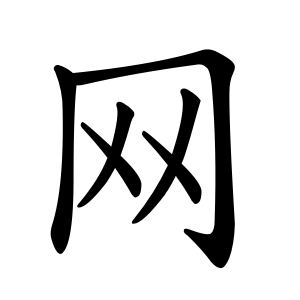网
- net;
It referring to a tool made by weaving threads or strings, used to catch fish, birds, or animals.
Etymology
In terms of character formation (etymology), it is a semantic compound, composed of:
冖 — representing a covering element,
XX — symbolizing the mesh or pattern of a net.
Usage in Korean
When used as a radical, it generally relates to meanings involving hunting or fishing tools, things that catch or trap, things that hold or restrain, and matters relating to laws or prohibitions.
In the clerical script (隸書 lìshū), there are variant forms such as 𦉰, 㓁, 罒, and 罓, with 罒 being the most commonly used form.
In Chinese dictionaries, only 罒 is recognized as the radical form. Therefore,
罔 is found under the 冂 radical,
罕 is found under the 冖 radical,
and since the basic form of the radical is 罒, not 网, characters with the 网 form are also listed under the 冂 radical.
Alternative forms
𦉰 appears only in 罔 (meaning "none" or "without").
㓁 appears only in 罕 (meaning "rare") and 罙 (meaning "gradually increasing").
罓 is rarely used.
- 月大大 (BKK)
- ⿵ 冂 ⿰ 㐅 㐅
